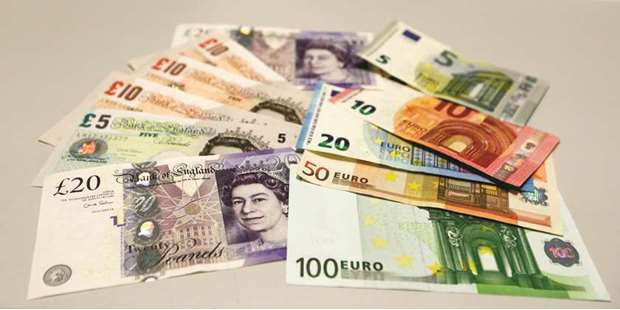What was considered best avoided in European currencies and bonds a year ago is just what’s topping 2018’s hottest picks.
The pound and the euro, which analysts shunned at the end of 2016 predicting doomsday scenarios, are the very thing they are recommending for next year. As for bonds, well, good luck if you own them since they reckon yields will climb as major central banks begin to end monetary stimulus.
“As the post-financial crisis policy architecture – which boosted asset prices and anchored bond yields, credit spreads and volatility – is unwound, investors need to choose between holding on to carry, which may be all they have left, and finding a safe place to hide,” Kit Juckes, a strategist at Societe Generale in London, wrote in a note to clients. “Beware of sleeping volcanoes.”
Here are some of the top trade recommendations and views for 2018: Buy pound
Brexit still seems to throw up more questions than answers, but one thing most analysts seem to agree on is that the pound is likely to strengthen next year. That view is mostly pegged to the conviction that the UK will achieve a transitional arrangement with the European Union before the country leaves the bloc in March 2019.
Bank of America Merrill Lynch’s preferred trade is to buy sterling versus an “overvalued” Swiss franc while ING Group sees the British currency reaching $1.40 next year, a call an increasing number of strategists are shifting toward, and then rising further toward $1.50 by end-2018.
The pound was little changed at $1.3397 in London last week. The currency has strengthened almost 9% this year after losing 16% of its value in 2016 after the UK voted to leave the EU. Sterling “has suffered since the Brexit vote, but a lot of bad news is already in the price,” ING strategists led by Chris Turner wrote in a note to clients. An agreed deal “will be the antidote to the pound’s uncertainty-driven weakness, triggering a positive re-appraisal of the UK economic outlook and a hawkish re-pricing of Bank of England policy expectations.”
Euro still got legs
The euro is the best Group-of-10 performer of 2017, confounding many who had predicted that this year’s events could presage the common currency’s demise. Goldman Sachs Group, Morgan Stanley, Societe Generale and ING still remain bullish as the European Central Bank unwinds stimulus and the continent’s growth outlook continues to improve.
“FX reserve managers have not started to cover their substantial euro underweight” positions, Goldman Sachs strategists led by Francesco Garzarelli, who recommend a long position in the single currency versus the yen as a way to work around a flat dollar, wrote in a note.
“Continued inflows into euro-area assets should support the euro, even as interest rates remain low.”
The euro fell 0.1% to $1.1779; it has rallied 12% this year. Societe Generale sees the common currency benefiting from a potential increase in bund yields next year, while Morgan Stanley expects it to strengthen versus the Swiss franc.
Watch out for Italy
With this year’s French and Dutch elections passing without political upsets, the risk is that investors may grow complacent about region’s next political worry: Italy. The country has elections due before May, with the anti-establishment Five Star Movement currently leading in some polls. Credit Agricole, Citigroup and JPMorgan Chase & Co are recommending bearish positions in Italian bonds into the new year.
“We continue to believe it will be the Italian election that has the potential to generate more in terms of spread turbulence,” Citigroup strategists Jamie Searle and Aman Bansal wrote in a note to clients.
“We therefore enter 2018 with a bearish view on BTPs.”
Bunds trumped by Treasuries
For almost all banks, 2018 is the year that will see bond yields move higher. French debt will likely face supply headwinds, while the removal of ECB purchases will begin to weigh on German bunds. JPMorgan recommends outright short positions in the 10- and 30-year tenors on Europe’s safest securities.
Credit Suisse sees bunds as one of the biggest losers with 10-year yields rising to 1% from 0.29%, while Morgan Stanley and Credit Agricole recommend selling German debt versus US Treasuries.
“We particularly see upside risks to bund yields,” Credit Suisse strategists led by Andrew Garthwaite wrote. “We can see yields ending 2018 close to 1% given the strength of European growth, overly conservative ECB rate expectations, the end of QE in September 2018 and some signs that inflation is being underestimated.”
Portuguese exception
With a potential reentry into various key bond indexes in January, Portugal is the exception that proves the rule. The bullish outlook depends on an upgrade to investment grade by Fitch Ratings later this month, marking the second of the big three ratings agencies to do so.
Rabobank International, JPMorgan, and Credit Agricole remain bullish even after the country’s bonds notched up their eighth consecutive monthly gain in November.
There is “an apparent sea change of sentiment in Portugal – Portugal looking to finally be regaining peripheral status as it escapes the gravitational pull of the bailout era,” Rabobank strategists led by Richard McGuire wrote in a note to clients, predicting the yield spread over Germany to narrow by as much as 40 basis points from around 158 basis points.

The pound and the euro, which analysts shunned at the end of 2016 predicting doomsday scenarios, are the very thing they are recommending for next year


